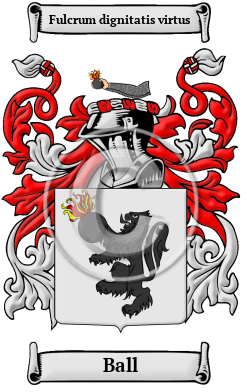-
Birth name
Meisa Tien Ball
-
TRIBAL AFFILIATION
Cherokee
-
SURNAME HERITAGE
England France Ireland

Ball History, Family Crest & Coats of Arms
The ancient Anglo-Saxon culture of England produced the name of Ball. It was given to a person who was bald deriving its origin from the Old English word Bealla, which meant bald. The surname may also refer to someone who had a rotund or stocky stature. 1
While many researchers share this same “nickname” origin of the name, Henry Brougham Guppy in 1890, wrote “The idea that these names originated from bald – headed ancestors is, I think, absurd. Camden, in his remarks on surnames, written some 300 years ago, informs us that Baul and Bald were then nicknames or nursenames for Baldwin, and it was evidently from this source that Mr. Lower borrowed the suggestion that Ball was a nickname of Baldwin.” 2
Early Origins of the Ball family
The surname Ball was first found in the “west side of England, being at present most numerous in Lancashire, Staffordshire, Warwickshire, and Gloucestershire. This surname must be distinguished in its distribution from Balls, which is restricted to the opposite or east side of England, in the counties of Norfolk, Suffolk, and Essex. It is remarkable that after the lapse of six centuries Balls remains doggedly in the same part of England, whilst Ball and Baldwin seem to have extended their areas westward. In Norfolk three centuries ago Balls was sometimes spelt Balles or Ballis. ” 2
The earliest record of the family was found in the Hundredorum Rolls of 1273 which reflected the scattered occurrences of the family and early spellings recorded: Custance Balde, Cambridgeshire; Richard Bald, Oxfordshire; John Balle, Norfolk; and Albred Balle, Huntingdonshire. 1
Kirby’s Quest had several entries: John Balde, Somerset, 1 Edward III (recorded during the first year’s reign of Edward III.) John atte Balle, Somerset, 1 Edward III; and Henry atte Balle, Somerset, 1 Edward III. 3
John Ball (d. 1381), was an early English priest, who provoked the insurrection of Wat Tyler. As a result of his actions, he was “brought before the king at St. Albans, where he was sentenced to be hanged, drawn, and quartered as a traitor. The sentence seems to have been promptly carried out, and the king himself witnessed its execution at St. Albans on 15 July. ” 4


